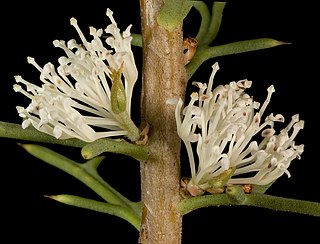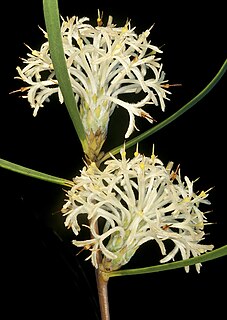
Grevillea argyrophylla, the silvery-leaved grevillea, is a species of flowering plant in the family Proteaceae and is endemic to the south-west of Western Australia. It is an erect, sometimes low-lying shrub with egg-shaped leaves with the narrower end towards the base, and white flowers, sometimes tinged with pink.
Hibbertia australis is a species of flowering plant in the family Dilleniaceae and is endemic to south-eastern continental Australia. It is an erect to spreading shrub with linear leaves and yellow flowers with four to nine stamens arranged in a single cluster.

Persoonia arborea, commonly known as tree geebung, is a species of large shrub or small tree that is endemic to Victoria, Australia.
Westringia cremnophila, commonly known as Snowy River westringia, is a flowering plant in the family Lamiaceae, a rare shrub that is endemic to Victoria, Australia. It is a small shrub with leaves mostly in groups of three and white flowers.

Cassinia aureonitens, commonly known as the yellow cassinia is a species of flowering plant in the family Asteraceae and is endemic to eastern New South Wales. It is a shrub with elliptic leaves and heads of yellow flowers arranged in dense corymbs.

Cassinia subtropica, commonly known as bushy rosemary, is a species of flowering plant in the family Asteraceae and is endemic to north-eastern Australia. It is shrub with woolly-hairy stems, lance-shaped to egg-shaped leaves and panicles of flower heads.

Cassinia trinerva is a species of flowering plant in the family Asteraceae and is endemic to south-eastern Australia. It is an erect shrub or small tree with hairy stems, narrow lance-shaped leaves, and flower heads arranged in dense corymbs.

Hakea varia, commonly known as the variable-leaved hakea, is a shrub of the family Proteacea and endemic to Wheatbelt, South West, Great Southern and Goldfields-Esperance regions of Western Australia. It is a dense prickly shrub with creamy-white or yellow flowers and variable shaped leaves.

Hakea megadenia is a shrub or tree of the family Proteacea endemic to an area along the east coast of Tasmania and the Furneaux Island group off the coast of Tasmania.

Petrophile heterophylla, commonly known as the variable-leaved conebush, is a species of flowering plant in the family Proteaceae and is endemic to southwestern Western Australia. It is a shrub with variably shaped, sometimes pinnately-divided leaves, and oval heads of silky-hairy, yellow to cream-coloured flowers.

Phebalium lepidotum is a species of rounded shrub that is endemic to Western Australia. It has scaly branchlets, leathery, narrow oblong leaves and white to cream-coloured flowers arranged in umbels of between three and six on the ends of branchlets.
Phebalium obovatum is a species of spreading shrub that is endemic to Western Australia. It has thick, egg-shaped or elliptical leaves densely covered with silvery scales on the lower side and white flowers arranged in umbels with silvery or rust-coloured scales on the back.

Phebalium tuberculosum is a species of erect shrub that is endemic to Western Australia. It has glandular-warty and scaly branchlets and leaves and white flowers arranged in umbels of three or four with rust-coloured scales on the back of the petals.
Phebalium verrucosum is a species of shrub that is endemic to New South Wales. It has branchlets densely covered with white scales, narrow elliptic, oblong or linear leaves covered with white scales on the lower side, and umbels of creamy white flowers with silvery or rust-coloured scales on the back of the petals.

Prostanthera althoferi is a species of flowering plant in the family Lamiaceae and is endemic to inland areas of Australia. It is an erect shrub with its stems and leaves densely covered with silvery, greyish-green hairs, and has narrow egg-shaped leaves and white to cream-coloured flowers with mauve or purple striations inside.

Prostanthera sericea, commonly known as silky mintbush or walyuwalyu, is a species of flowering plant in the family Lamiaceae and is endemic to inland Australia. It is an erect shrub with hairy branches, cylindrical leaves and white flowers with mauve or purple streaks.

Teucrium eremaeum is a species of flowering plant in the family Lamiaceae and is endemic to the south-west of Western Australia. It is a perennial herb or shrub with small, linear to lance-shaped leaves and white or cream-coloured flowers.
Triplarina nowraensis, commonly known as Nowra myrtle heath, is a species of flowering plant in the myrtle family, Myrtaceae and is endemic to a restricted area of New South Wales. It is a shrub with egg-shaped to lance-shaped leaves with the narrower end towards the base, flowers with five sepals, five cream-coloured to white petals and fifteen to seventeen stamens.

Pomaderris andromedifolia is a species of flowering plant in the family Rhamnaceae and is endemic to south-eastern continental Australia. It is a shrub with lance-shaped to elliptic leaves and cream-coloured to yellow flowers.

Pomaderris angustifolia is a species of flowering plant in the family Rhamnaceae and is endemic to south-eastern continental Australia. It is a shrub with linear to narrowly oblong leaves and cream-coloured or yellow flowers.















